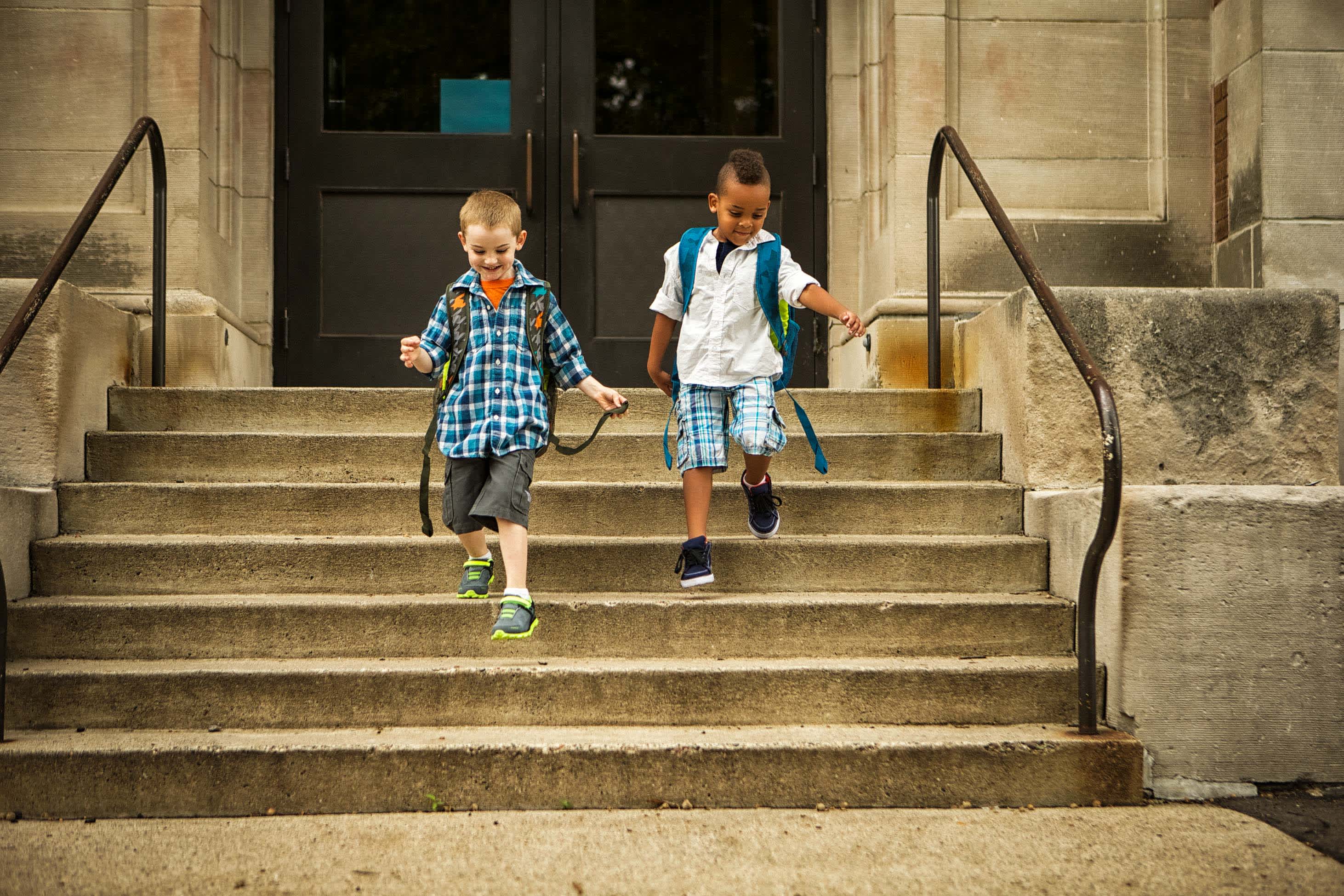Work, Life, Balanced
Here Are the Things You Should Know When You Have a 5-Year-Old
By Beth Braverman — Feb 11, 2020

Congratulations, you’ve survived the preschool years!
When you enter the land of kindergarten, you get the incredible experience of watching your child develop self confidence and test out their independence. All while adjusting to the loss of naps and a new school schedule. (It’s probably you who’s doing most of the adjusting.)
Each year brings unique challenges. Here’s how to get situated when you’ve got a 5-year-old on your hands:
1. Don’t Downplay the Big Changes
Whether your child is starting kindergarten this year or next, they're about to enter a whole new environment with new people, new routines and new expectations. Spend some time ahead of the transition, and throughout the year, helping them adjust.
Take advantage of any programs the school offers to help with the adjustment, such as a chance to tour the school or meet the teachers ahead of time. You might also spend some time playing at the school’s playground, if permitted, before the school year starts.
“Parents should be mindful that kids are going to ask a lot of questions,” Cami Winkelspecht, a pediatric psychologist with Nemours Alfred I. duPont Hospital for Children, says. “That’s a good thing. Solicit their questions and their feedback about what’s happening each day.”
2. Think About Protecting Your Family Financially
After years of paying for childcare or living on one income, it’s more than possible that it’s been a struggle to maintain a financial cushion of three to six months’ worth of expenses. In fact, one study found that fewer than half of mid-career employees (ages 30 to 44) had an emergency fund.
Look at your budget to see if there are areas where you can find extra cash to direct to that rainy day fund. Setting aside money for emergencies will keep you from having to turn to options like credit cards or a 401(k) loan if you lose your job or get slammed with an unexpected medical bill.
Another potential way to help protect your family against the unknown is to consider life insurance. If you’re not already covered, now could be a good time to learn more about how life insurance works or apply for a term life insurance policy.
3. Focus on Routine
While 5-year-olds typically have the motor skills to handle basic self-care tasks such as getting dressed, brushing their own teeth and feeding themselves, getting them to actually accomplish those tasks every morning can still be a challenge. You can help by sticking firmly to a morning routine.
Each morning, for example, you might remind your children to pick out an outfit, then get themselves dressed, then brush their teeth, before sitting down for breakfast.
The goal, says Winkelspecht, is to make the schedule predictable. This “helps them to become more independent,” she says, “so they don’t have to rely on a parent to tell them what to do.”
4. Slash Your High-Interest Debt
Once you’ve established your emergency fund (and after getting an employer match for your retirement savings), consider directing extra cash toward getting rid of any high-interest debt. That’ll free up more money each month and make it easier to hit other financial goals.
You might try the "snowball method," which means you'd start by focusing on the account with the highest interest rate, while continuing to make minimum payments on any other accounts. Once that’s paid off, you can redirect your cash to the account with the next-highest rate.
5. Practice Sharing
In order to succeed socially in elementary school, children need to know how to share—a skill not everyone practices in preschool. Think broadly about sharing: In addition to physical objects, it’s important for 5-year-olds to understand how to share physical space and the attention of others. Practice by playing games that require taking turns or hosting playdates in your home.
The concept of sharing can also apply to charity. At this age, your child can understand the concept of donating goods such as baby toys or outgrown clothing. “Have your children participate in that process of picking things out,” says child psychologist Kathleen Cuneo. “Talk to them about how some people have harder situations and we want to help them out.”
We put together 14 ideas for teaching kids about charity.
6. Explain ‘Wants’ vs. ‘Needs’
Children at this age are highly susceptible to advertising, but they’ll also still listen when you describe why it’s not possible to have everything that they want. Spend some time at the supermarket or while back-to-school shopping. Pause to discuss whether purchases are wants or needs, and why you’ve decided to buy certain items (or not).
Make it clear, as well, that your child’s allowance should go toward purchasing “wants,” while you’ll still cover the family’s needs.
Do you find it difficult to say no? Here’s how—and when—to say no to kids.
7. Weigh Private School vs. Public School
Kindergarten gives you a first-hand look into your school system, and it’s often when many families start considering whether a transition to private school might make sense. While you may want to make the decision based on your emotions, deciding on public vs. private school can have significant financial consequences.
Private elementary school tuition averages more than $9,000 per year and can reach nearly double that in areas with a higher cost of living.
Still, there are often financial aid programs available at private schools. For many families, paying for private school is a choice for which it’s worth making other sacrifices. You might also consider a religious private school, where tuition tends to be less expensive. The average Catholic school, for example, charges less than $5,000 per year for elementary school tuition.
8. Talk About Emotions
While there may still be some break-through temper tantrums, children at this age are starting to gain a bit more control over their emotions. Help your kindergartner out by teaching them to recognize her own emotions. That includes helping them identify both positive and negative emotions.
You might say, “I can see that leaving the party made you sad,” or, “Great job! How did it feel to make it across the monkey bars for the first time?”
9. Going Back to Work After Baby?
Many parents take a professional step back when their children are little, whether that means opting out of the workforce entirely or not putting themselves forward for promotion. Now that your children are getting older, take some time to reassess your current career path and think about what changes you might want to make.
If that means going back to work, you’ll want to start networking again and looking for projects to help freshen up your resume. “Start thinking about what type of flex work you could do that would allow you to relaunch your career, or if there’s a smaller business you could work on that could grow into a bigger business later,” says Cynthia Meyer, a certified financial planner with Financial Finesse.
Age 5 is a year of transition, for both you and your child. As you adjust to having a school-age child, you have the power not just to help them develop his skills but also to bond and develop your relationship as you move into the next stage together.
Curious about the future? Preview what you should know when your kid turns 6. Or get money to-dos for the first 10 years of your child's life.
Fabric exists to help young families master their money. Our articles abide by strict editorial standards.
Information provided is general and educational in nature, is not financial advice, and all products or services discussed may not be offered by Fabric by Gerber Life (“the Company”). The information is not intended to be, and should not be construed as, legal or tax advice. The Company does not provide legal or tax advice. Consult an attorney or tax advisor regarding your specific legal or tax situation. Laws of a specific state or laws relevant to a particular situation may affect the applicability, accuracy, or completeness of this information. Federal and state laws and regulations are complex and are subject to change. The Company makes no warranties with regard to the information or results obtained by its use. The Company disclaims any liability arising out of your use of, or reliance on, the information. The views and opinions of third-party content providers are solely those of the author and not Fabric by Gerber Life.

Written by
Beth Braverman
Related Posts
Work, Life, Balanced
CFPs, Money Coaches and More: Which Financial Professional Is Right for You?
A financial professional can help you manage your money. What type of financial pro you need can depend on the kind of help you’re looking for.
By Jessica Sillers
Work, Life, Balanced
What Parents Need to Know About Taxes in 2025
Tax credits or deductions can help families lower taxes and keep more money to enjoy with your kids.
By Jessica Sillers
Work, Life, Balanced
Does Your Partner Lie About Money? Ways to Find—and Fix—Financial Infidelity
Financial infidelity, or being dishonest about money with your partner, can affect your finances and relationship. Spot unhealthy patterns and learn ways to build money habits that strengthen your bond.
By Jessica Sillers
Fabric Picks
Life insurance
What to Do at the End of Your Life Insurance Term
Term life insurance, by definition, ends. Check that you’re ready for a smooth transition out of your policy, or take steps to continue the best coverage fit for you.
By Jessica Sillers
Saving/Investing for Kids
Investing Strategies for Beginners
Investing can be a sound strategy to help grow your finances over time. Start by identifying which strategy and account type works best for you.
By Jessica Sillers
Life insurance
How to File a Life Insurance Claim
A life insurance claim starts the process for you to collect your benefit. Learn how to file a claim and when you might receive money from the insurance company.